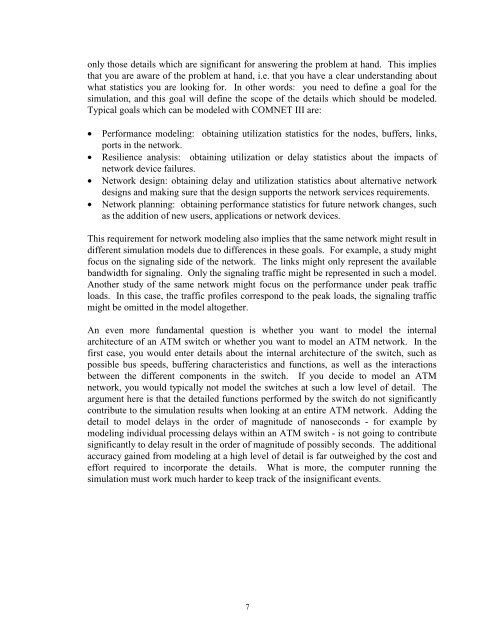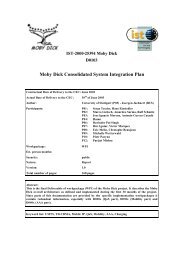COMNET III CACI
COMNET III CACI
COMNET III CACI
Create successful ePaper yourself
Turn your PDF publications into a flip-book with our unique Google optimized e-Paper software.
only those details which are significant for answering the problem at hand. This implies<br />
that you are aware of the problem at hand, i.e. that you have a clear understanding about<br />
what statistics you are looking for. In other words: you need to define a goal for the<br />
simulation, and this goal will define the scope of the details which should be modeled.<br />
Typical goals which can be modeled with <strong>COMNET</strong> <strong>III</strong> are:<br />
• Performance modeling: obtaining utilization statistics for the nodes, buffers, links,<br />
ports in the network.<br />
• Resilience analysis: obtaining utilization or delay statistics about the impacts of<br />
network device failures.<br />
• Network design: obtaining delay and utilization statistics about alternative network<br />
designs and making sure that the design supports the network services requirements.<br />
• Network planning: obtaining performance statistics for future network changes, such<br />
as the addition of new users, applications or network devices.<br />
This requirement for network modeling also implies that the same network might result in<br />
different simulation models due to differences in these goals. For example, a study might<br />
focus on the signaling side of the network. The links might only represent the available<br />
bandwidth for signaling. Only the signaling traffic might be represented in such a model.<br />
Another study of the same network might focus on the performance under peak traffic<br />
loads. In this case, the traffic profiles correspond to the peak loads, the signaling traffic<br />
might be omitted in the model altogether.<br />
An even more fundamental question is whether you want to model the internal<br />
architecture of an ATM switch or whether you want to model an ATM network. In the<br />
first case, you would enter details about the internal architecture of the switch, such as<br />
possible bus speeds, buffering characteristics and functions, as well as the interactions<br />
between the different components in the switch. If you decide to model an ATM<br />
network, you would typically not model the switches at such a low level of detail. The<br />
argument here is that the detailed functions performed by the switch do not significantly<br />
contribute to the simulation results when looking at an entire ATM network. Adding the<br />
detail to model delays in the order of magnitude of nanoseconds - for example by<br />
modeling individual processing delays within an ATM switch - is not going to contribute<br />
significantly to delay result in the order of magnitude of possibly seconds. The additional<br />
accuracy gained from modeling at a high level of detail is far outweighed by the cost and<br />
effort required to incorporate the details. What is more, the computer running the<br />
simulation must work much harder to keep track of the insignificant events.<br />
7
















